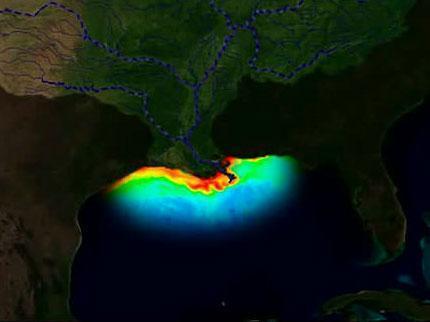Climate change, sewage and fertilisers could trigger mass extinction of life in oceans, scientists warn
Areas of low oxygen known as 'dead zones' are spreading, killing or forcing marine life to flee

The ocean is slowly being suffocated with levels of oxygen falling at a similar rate to 94 million years ago when there was a mass extinction of marine life, scientists have warned.
While that event was caused naturally, humans are responsible for several different factors driving the increase in “dead zones” in our seas.
One is that sewage and fertilisers running off farmers fields are causing massive blooms of algae that die and then decompose in a process that consumes oxygen. This kills most marine life or forces mobile animals such as fish to flee.
One of the world’s biggest “biological deserts” is in the northern Gulf of Mexico, centred on the mouth of the Mississippi River. The Baltic Sea is also severely affected.
Another factor driving the process is that global warming is gradually increasing the amount of erosion of the land, adding extra nutrients to the sea. However this process is expected to take tens of thousands of years.
The loss of oxygen from the ocean is yet another problem facing marine life along with rising temperatures and ocean acidification, caused by absorption of increasing amounts of carbon dioxide from the atmosphere.
Writing in the journal Science Advances, the researchers said that current rates of deoxygenation were similar to those 94 million years ago during what is known as Oceanic Anoxic Event-2 (OAE-2).
“Increased ocean deoxygenation is already apparent in the modern ocean, because marine dioxygen has decreased by two per cent over roughly the last half century, and recent models predict a continued loss of 0.5 to 3.5 per cent over the next half century, which would result in huge expansions of ocean anoxia within the next few thousand years,” they said.
“Should anthropogenically induced oxygen loss occur at similar rates as in the period leading up to OAE-2, then the current area of seafloor hypoxia would double in about the next 102 to 344 years.
“Localised oxygen loss is already apparent in the modern ocean, and the ability to observe more widespread perturbation seems realistic under currently projected carbon emissions.
“Without positive human intervention, ancient OAE studies are destined to become uncomfortably applicable in the not-so-distant future.”
OAE-2, which developed over about 50,000 years, is believed to have caused the extinction of about 27 per cent of marine invertebrates.
One of the researchers, Dr Sune Nielsen, of Woods Hole Oceanographic Institution in the US, said: “Our results show that marine deoxygenation rates prior to the ancient event were likely occurring over tens of thousands of years, and surprisingly similar to the two per cent oxygen depletion trend we’re seeing induced by anthropogenic activity over the last 50 years.
“We don’t know if the ocean is headed toward another global anoxic event, but the trend is, of course, worrying.”
Join our commenting forum
Join thought-provoking conversations, follow other Independent readers and see their replies
Comments
Bookmark popover
Removed from bookmarks